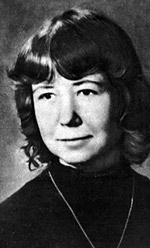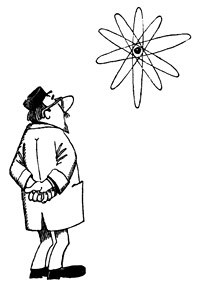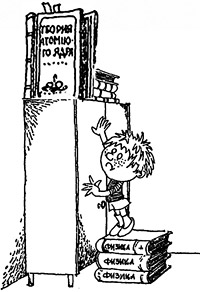
Electronic english version since 2022 |
The newspaper was founded in November 1957
| |
|
Number 46 (4694) |
I wish to know everything!
Look how beautiful the microcosm is!
The books of the series "Eureka" that have once existed are easily recognizable. Among other popular science publications, they stand out because of their cover, their entertaining nature and their richness of illustrations. Take any one and on the fifth page, or even earlier, you will see a drawing, often humorous, on another topic from the history of science. Among the reputable authors that condescended to "Eureka" is Academician Arkady Migdal ("Search for Truth", 1976) and in 1966, a Russian translation of "The Evolution of Physics" by Albert Einstein and Leopold Infeld was published in this series.
 Over three hundred books have been published in the series "Eureka". Two of them are written by Vera Chernogorova. The first one, "Mysteries of the Microworld" was published exactly 50 years ago. The sparse biographical information on the back cover says: "Vera Aleksandrovna, after having graduated from the Faculty of Physics and Mathematics of the University, enters graduate school at the Lebedev Physical Institute and later, becomes an employee of the Joint Institute for Nuclear Research in Dubna. For almost 12 years, she participated in experiments at the synchrocyclotron, a particle accelerator. Vera Aleksandrovna is a co-author of many scientific papers on the investigation of the properties of mu-mesons... "Mysteries of the Microworld" is her first book in which she introduces readers to some current issues in the physics of elementary particles."
Over three hundred books have been published in the series "Eureka". Two of them are written by Vera Chernogorova. The first one, "Mysteries of the Microworld" was published exactly 50 years ago. The sparse biographical information on the back cover says: "Vera Aleksandrovna, after having graduated from the Faculty of Physics and Mathematics of the University, enters graduate school at the Lebedev Physical Institute and later, becomes an employee of the Joint Institute for Nuclear Research in Dubna. For almost 12 years, she participated in experiments at the synchrocyclotron, a particle accelerator. Vera Aleksandrovna is a co-author of many scientific papers on the investigation of the properties of mu-mesons... "Mysteries of the Microworld" is her first book in which she introduces readers to some current issues in the physics of elementary particles."
If Herzen Kopylov set himself the goal of proving that a modern schoolchild is able to repeat after adults some calculations from "adult" high-energy physics and Leonid Ivanovich Ponomarev outlined in an accessible form the history of the wonderful ideas that gave rise to quantum theory, then Vera Chernogorova's book is a story about what the "pathfinders of the microworld" of that time did. The book, of course, also notes the Dubna trace in science. Ultracold neutrons that can be stored in a jar (and one of these was given to Ilya Mikhailovich Frank), "frozen" targets and the "refrigerator" of B.S.Neganov, mesochemistry at the Laboratory of Nuclear Problems, the supersonic gas target technique of V.A.Nikitin and his team, successfully used in Protvino and then overseas, in Batavia...
 Half a century has passed since then. Many mysteries of the microworld, over which physicists of those years puzzled, have already been solved. In 1973, the year the book was published, the theory of strong interactions was born, on which the modern physical picture of the world rests and it became clear why quarks were never discovered in a free state. In 1975, Raymond Davis finally caught solar neutrinos and Bruno Pontecorvo explained why there were three times fewer of them than expected. In the early 1980s, physicists at CERN discovered the W and Z bosons, thereby confirming the theory of electroweak interactions, the second pillar of the so-called Standard Model. 11 years ago, at the Large Hadron Collider at the same CERN, the last particle predicted within the Standard Model was discovered - the Higgs boson... But the Dirac monopole that V.P.Zrelov's group looked for, has not yet been found. The electric dipole moment of the neutron, for the sake of which FLNP physicists learned to isolate ultracold neutrons from the general flux, was also not discovered...
Half a century has passed since then. Many mysteries of the microworld, over which physicists of those years puzzled, have already been solved. In 1973, the year the book was published, the theory of strong interactions was born, on which the modern physical picture of the world rests and it became clear why quarks were never discovered in a free state. In 1975, Raymond Davis finally caught solar neutrinos and Bruno Pontecorvo explained why there were three times fewer of them than expected. In the early 1980s, physicists at CERN discovered the W and Z bosons, thereby confirming the theory of electroweak interactions, the second pillar of the so-called Standard Model. 11 years ago, at the Large Hadron Collider at the same CERN, the last particle predicted within the Standard Model was discovered - the Higgs boson... But the Dirac monopole that V.P.Zrelov's group looked for, has not yet been found. The electric dipole moment of the neutron, for the sake of which FLNP physicists learned to isolate ultracold neutrons from the general flux, was also not discovered...
 |
| Vera Chernogorova's second book "Talks about the Atomic Nucleus" was published in 1976 |
About the author of the drawings. Architect, artist and book graphic artist Konstantin Moshkin illustrated more than fifty books and almost half of them were published in the series "Eureka". Sometimes his drawings, initially tied to the text, acquire their own existence as happened, for example, with a drawing in which an oriental genie, reminiscent of the old man Hottabych suggests stereotypes of classical physics to a 20th-century physicist.
Alexander RASTORGUEV